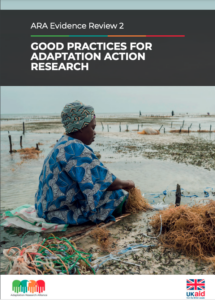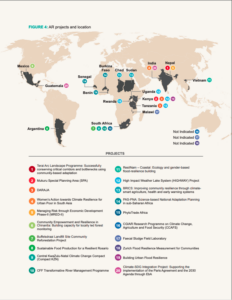What Does it Take to Bridge the Gap between Adaptation Research and Action? – A Review of Good Practice in the Global South
Climate change adaptation to be effective and informed by the latest science on climate change, the consideration and integration of scientific knowledge and research is crucial. However, there is a perceived mismatch between academic research and local adaptation action on the ground. Even though specific knowledge is circulated and available within the ‘research and expert bubble’, it is often not usable for local communities who either do not know where to look for relevant data and information, have a lack of resources or missing capacities to translate scientific outcomes into action. This not only calls for knowledge brokering, as we made this the DNA of our work, but also closer collaboration of researchers and practitioners in the first place.
 Linking adaptation research and action more closely
Linking adaptation research and action more closely
The Adaptation Research Alliance has designed six Adaptation Research for Impact Principles, which should help to overcome the barriers in adaptation research, such as a disconnect between research and the needs of the most vulnerable, or limited learning from implementation. The principles call for
- Research is needs-driven, solutions-oriented and leads to a positive impact on the lives of those at risk from climate change (Who or what is the research for?)
- Research is transdisciplinary and co-produced with users (How should research be carried out?)
- Research emphasises societal impact (How is research valued?)
- Research builds capacity and empowers actors for the long term (What can research enable?)
- Research processes address structural inequities that lead to increased vulnerability and reduced adaptive capacity for those at risk (How can research address root causes of risk?)
- Learning-while-doing enables adaptation action to be evidence-based and increasingly effective (How can research–action links be strengthened?)
How to put these principles into practice?
The PlanAdapt team around Sumetee Pahwa Gajjar, Alannah Hofemeier, Martin Rokitzki and Carys Richards, in close collaboration with the Secretariat of the Adaptation Research Alliance have now published a report on Good Practices for Adaptation Action Research.
The report showcases evidence of adaptation action research in practice while offering preliminary insights into how the principles emerge and interact in particular contexts. The findings are based on an analysis of twenty projects and initiatives which have – intentionally or not – incorporated the principles into some elements of their work on adaptation. The analysis is aimed to generate a better understanding of how the principles can be operationalised in different ways.

Close collaboration with local communities is at the centre of impact-oriented research
Projects that applied participatory approaches and aimed for a close collaboration of researchers and the most vulnerable, by putting their needs and voices at the centre, often fulfilled multiple principles. Moreover, projects and initiatives that were rated as exemplary in fulfilling one of the principles, almost always incorporated similar values into their project design or research process right from the beginning. The intentional integration of criteria at the beginning of the programme design is therefore crucial to succeeding in intended outcomes. When the principles are put into practice, there are often overlaps and strong synergies between them, showing how the application of one or more principles often leads to the facilitation of another.
There is a need to consolidate with practitioners and define relevant terms
This analysis is a first step in analysing how the principles can be operationalized and put into practice. It calls for further consolidating the outcomes from the evidence review with practitioners, in order to understand and learn from the finer details on how project outcomes were achieved, the challenges encountered and how they were overcome. Additionally, it needs further discussion on terms such as action research, research for impact, and research into use, in order to establish a common understanding towards increased collaboration between different communities. Hence, further exchange and discussions are needed.
You can access the report here and gain a deeper insight and learning from the various exciting and inspiring projects.
